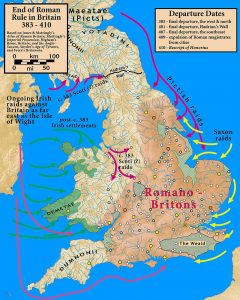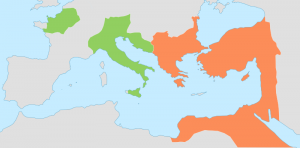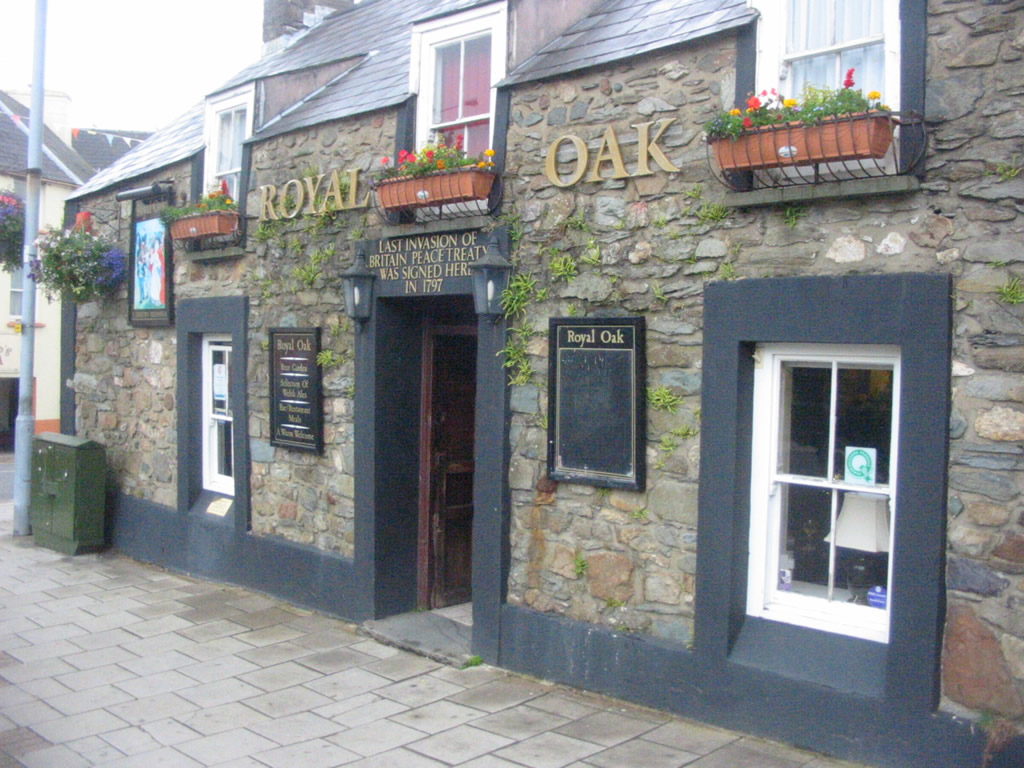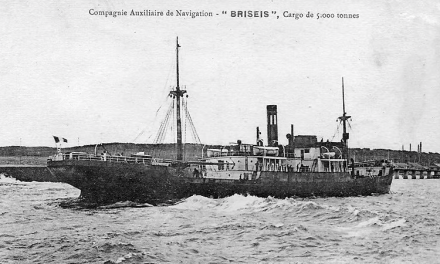
A Contextual Timeline for the Life of St Sampson
 313 AD : Rome accepts Christianity
313 AD : Rome accepts ChristianityConstantine the Great permits Christians to worship openly in the Roman Empire.
 410 AD : Rome Sacked
410 AD : Rome Sacked 460 AD : Gaul is Lost
460 AD : Gaul is LostThe Franks take Gaul back from the Romans. A key part of the Empire is lost forever.
 476 AD : End of Empire
476 AD : End of Empire c. 486 AD * : Samson is born
c. 486 AD * : Samson is bornSampson is born, into a noble family, in South Wales. His father was Amon of Dyfed, and mother Anna from the neighboring province of Gwent. (She was the daughter of King Meurig of Gwent.)
* There is only one date we can be certain of – the date of his ordination as bishop. If, as is usual, he was 35 years old at the time then he would have been born in 486.
 c. 491 AD : Training & Education
c. 491 AD : Training & EducationAt the age of 5 years Samson was taken by his parents to the school of St. IItut at Llantwit near Cowbridge. While there he was eventually ordained a deacon and then a priest.
 {Date Unknown} : Caldey Island
{Date Unknown} : Caldey IslandAfter being ordained as a priest, and in response to a heavenly call, he went to a monastery run by a monk called Piro on Caldey Island.
On the death of Piro, having fallen down a well while drunk, Samson replaced him as abbot.
 c. 516 AD : 1st Mission
c. 516 AD : 1st MissionIt’s at this point that he took his first step in his career as an influential missionary when he undertook a journey to Ireland.
 521 AD : Ordination as Bishop
521 AD : Ordination as BishopAt age 35, Sampson is ordained as a bishop on the “Feast of the Chair of St. Peter (February 22), on a Sunday, at the beginning of Lent.“
 c. 521 - 525 AD : Missionary Trips
c. 521 - 525 AD : Missionary TripsAfter his ordination, and perhaps finding himself free to act on his own initiative, he bade fare well to the monastery where he had succeeded Piro, and sailed to Cornwall and the Scilly Isles (where the island of Samson is named after him)
 c. 525 AD : Dôl
c. 525 AD : DôlSamson embarks from Fowey (where he had also established a monastery) for Brittany with his cousin, and sometimes confusingly described as nephew, St. Magloire. In Brittany he was given some land on which to build a monastery. This site, in time, became the town of Dôl, which became the spiritual center of Brittany.
 c. 557 AD : Channel Islands added
c. 557 AD : Channel Islands addedSt Sampson asks Childebert (king of the Franks) for more lands to augment his small estate at Dôl. Childebert gives him 4 islands, later recorded by Bertrand d’Argentré (1519 – 1590), a court official in Rennes, as :
“To this archbishop, Childebert gave some islands and lands in Normandy: Rimoul, Augie, Sargie and Vesargie, which were islands off the coast, for so I find in the old documents“
Thus is set in place Samson’s ultimate motivation for his mission to Guernsey and the other Channel Islands, to win the islands for Christ.
 c.560 AD : Lands on Guernsey
c.560 AD : Lands on GuernseySamson lands in Guernsey, probably accompanied by his cousin Magloire (later St Magloire patron saint of Sark)
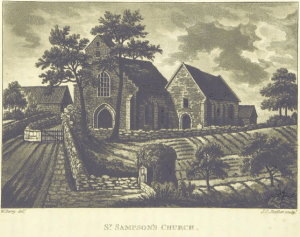 He first set foot on Guernsey in what was then and still is a natural harbour at a time when the pagan Islanders were “actively celebrating an evil feast on the first of January“
He first set foot on Guernsey in what was then and still is a natural harbour at a time when the pagan Islanders were “actively celebrating an evil feast on the first of January“Along with his followers he built a chapel near the landing place and it is highly likely that this early church stood on the same spot as the St Sampson’s parish church does today.
 565 AD : Samson dies
565 AD : Samson diesOn the 28th July 565 Samson dies in Dôl in Brittany. He is buried in the cathedral there.
 565 AD : Magloire succeeds his Uncle
565 AD : Magloire succeeds his UncleSt Magloire succeeded his cousin St. Sampson as bishop of Dôl in Brittany, but on the command of an angel he resigned his post on 565 and withdrew to Sark where he founded a Monastic community of 62 monks, gathered from all parts of Britain, Normandy and Brittany. The wooded valley where he built his monastery still bears the name of ‘la Moinerie’ today.
 c. 575 AD : Magloire dies on Sark
c. 575 AD : Magloire dies on SarkSt Magloire dies in Sark. His remains were translated in the 9th century to Lehon, near Dinan, and afterwards to Paris, where they were deposited in the church which still bears the name of the saint.
Samson

St Samson wasn’t just a local phenomenon but would have been regarded as something of a celebrity
It is St Sampson (originally spelled Samson*) who is credited with bringing the Christian Gospel, to not only Guernsey, but the whole of the Channel Islands. In all likelihood it is probable that the Channel Islands had already been visited by Christian missionaries prior to St Samson but it seems that it is his proselytisation which really made the lasting difference.
St Samson wasn’t just a local phenomenon but would have been regarded as something of a celebrity, a “rock star of his time”
Soon after his death it appears that the cult of St. Samson became general in many Celtic countries with him being revered by many of the Anglo-Saxon kings of the time. In an age where travel was extremely difficult and hazardous numerous pilgrimages were made from Britain, as well as from parts of Brittany, to his sarcophagus at Dôl. Indeed his fame spread beyond the Celtic parts, to Switzerland and Italy.
So St Sampson needs to be seen in a very much wider context than just his visits and impact he had on the Channel Islands.
*The accepted spelling of his name is with a “p”, but the French version is without that letter.
Setting the Scene
When Samson was born in 486 AD* the western Roman empire was dead – it had ended ‘officially’ 10 years earlier when the last Emperor, Romulus Augustus was deposed.
Samson was born into a land that Rome had abandoned over 75 year earlier when the last Roman Legions were withdrawn in 410AD. So we can imagine that Roman cultural influence was even weaker in post empire Britannia. He was born into a partly Christian society – Rome had first tolerated and then adopted the new Christian religion as long ago as 312 AD (See our article The Tipping Point – The Day Rome Embraced Christianity )
His family must have been deeply committed Christians because at the age of 5 he was taken by his parents to the school of St. IItut at Llantwit near Cowbridge. Whilst there he was eventually ordained a deacon and then a priest.
The world around him would not have been universally Christian. Britain was coming under the influence of many pagan invaders and since the collapse of Roman authority no doubt much of continental Europe was slipping back into pagan ways.
*Note : many dates for Samson have have had to be inferred from his main biography “The Life of St Samson of Dôl”. There is only one date we can be certain of – the date of his ordination as bishop. If, as is usual, he was 35 years old at the time then he would have been born in AD 486.
Sources for the Life of Samson
The life of St Sampson has been well documented in a work commissioned by the then abbot-bishop Tigernomalus not long after Samson’s death, around 610 AD, “The Life of St Samson of Dôl”.

Samsons [biography] was written within a decade or two of his death. We can therefore place more weight in this account.
Hagiographies, generally, of Saints are not always known to be very reliable especially because the lives of most other Celtic saints were usually written several centuries after their time. However Samson’s was written within a decade or two of his death. There is also independent evidence of Samson’s missions in the number of placenames and churches dedicated to him in Brittany, Maine, Normandy, Artois, Picardie, Beauvaisis, Orleanais and further afield.
And so … to Guernsey
We can therefore place more weight in this account from “The Life of St Samson of Dol”.
For when, on a certain occasion, he preached in the island of Lesia1, he arrived at the yearly return of the Kalends of January (i e., January 1st), because the men of the aforesaid island had been accustomed to celebrate, indeed beyond all others, this wretched anniversary according to a vile custom of their fathers. But he, prudent in spirit, to soften their hardness caused them all to come together to one place, and, God showing the way, a discussion took place for the removal of so great evils. Then all these men, truly loving him, for his sake anathematised these evils and truly promised to submit unreservedly to his directions. He, none the less rejoicing in the Lord, according to the Apostle’s (words), called to him all the young children, who were running about throughout the island on account of this abominable holiday, and gave to each of them, in solemn jest, by way of reward, a very trifling piece of gold, and instructed them in the name of the Lord that this impious custom must be no longer observed by them.
And so, to this day, in this same place spiritual jests have continued to be a sound and catholic (currency). 2
1Lesia is a Middle Ages’ corruption of Lisia – which is what we now think the Romans called Guernsey (see out article “Roman Guernsey“)
2text describing Samson’s visit to Lesia (Guernsey) from ‘The Life of St Samson of Dôl’ translated by Thomas Taylor
When Samson landed in Guernsey he was no novice but an experienced member of the church with a life time of missionary accomplishments and experiences behind him.
After being ordained as a priest Samson entered the monastery on Caldey Island where he rose to become the abbot. Later he decided to travel as a pilgrim for Christ, visiting Ireland, the Scilly Isles (where the island of Samson is named after him) and Cornwall. His biography relates several miraculous stories about his time in Cornwall so that Samson’s fame soon spread.
From Cornwall Samson crossed with his followers, one of which was his cousin Magloire – sometimes confusingly also described as his nephew , to Brittany.

And so the events were set in motion that would ultimately lead to his mission to Guernsey
In Brittany he was given a small parcel of land on which to build a monastery. This site, in time, became the town of Dôl, which also became the spiritual centre of Brittany.
Samson’s influence, both spiritual and political, grew to the point where in about 557 he asked king Childebert (king of the Franks) for more lands to augment his small estate at Dôl . Bertrand d’Argentré (1519 – 1590), a court official in Rennes in the 16th century, records : “To this archbishop, Childebert gave some islands and lands in Normandy: Rimoul, Augie, Sargie and Vesargie, which were islands off the coast, for so I find in the old documents”.
And so the events were set in motion that would ultimately lead to his mission to Guernsey and the other Channel Islands, to win the islands for Christ.
So, at the turn of the year in AD 560 Samson first set foot on Guernsey in what was then and still is a natural harbour. Along with his followers he built a chapel near to his landing place. It is highly likely that this early church stood on the same spot as the current St Sampson’s parish church.
We have no records of what he did or where he went whilst on Guernsey but there is no doubt about the results from a man who undoubtedly had much natural charisma and proselytising zeal.
St Sampson died around 565 AD but he left behind a legacy that has survived for nearly 1,500 years.
RELATED ARTICLES
| St Magloire – Patron Saint of Sark | |
| Monks on Herm | |
| The Tipping Point – The Day Rome Embraced Christianity |

